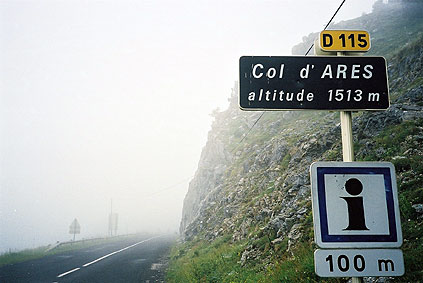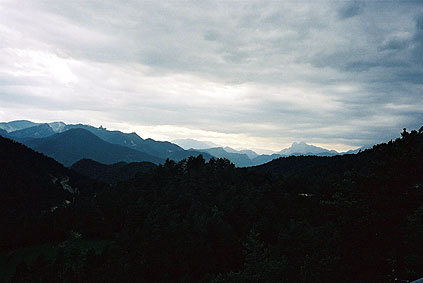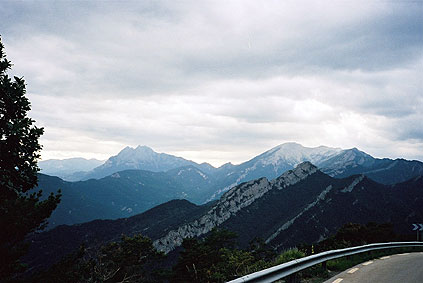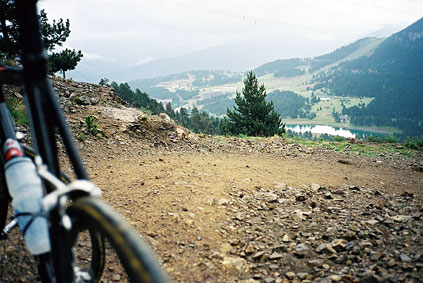
Left Amelie-les-Bains (230) rather quickly in the morning. The road up the Tech valley is quite nice with not so much traffic as I had expected. Met a young man/walker with a dog who asked how long it was to the next village (we both agreed on 9 km). It is fairly popular to walk far up in the Pyrenées, especially along the Santiago de Compostela road (and you are destined to meet some of these walkers on a trip through the Pyrenées). I probably cycled some stretches of this pilgrimage path, but I do not know exactly where it goes (but there are ample on literature and web sites on the subject).
Prats-de-Mollo (740) is a the last village before the border and is a very nice slightly touristic village. I had a coke and a look at some detailed local maps before starting out on the real climb up the Col d'Ares pass. Typically, the sign for the road going to Spain was for ”the frontier” – as if the french really does not recognise that country south of its borders (in Spain the signs are always properly pointing out that you will get to France on a road crossing the border). It is a bit steep up to the first col on this road – Col de la Seille (1185). From here you have pleasant views and a more gentle climb up to Col d'Ares (1513) via yet another pass named Col de la Guilla (1194).

The top section was in the fog. It is somewhat similar on the other side of this pass. Camprodon is also a village with much new built houses. I continued down to a little warmer place before I stopped for lunch. It took some time for me to get all the 4 or so courses. You can get a lot of food on the lunches here. I just picked at random among the choices as I hardly know any spanish, but it was okay and adds a little excitement. (I was a bit envious of the workers on bigger table that had order fresh pineapple though.) I could choose a bottle of wine or water as it was the same price and think I finally decided to get water, thankfully. (In Sweden the bottle of wine would have cost the double of the whole lunch.)
Further down there were some industries and the impression I got from northern Spain was that it was here people worked, while on the French side it was mostly quiet agriculture and tourism. The little road over Coll de Merolla (1090) was quite scenic and with a few farming villages not unlike somewhere on the French side. Coll de Merolla was a very easy climb and a very fun road to descend of the west side – not very steep but so curve-rich that the cars could not quite keep up with my speed anyway (even during some ups)

At La Pobla de Lillet (846) there were an old very special little railway that went up the hills to a castle. It seemed like the tourist spot along the road. There is a road going up here that I could have taken over to Puigcerda and stayed on tarmac all the time (actually there is only the long Viehla tunnel alternative further west – I am not clear if that tunnel is allowed for cyclists).
I was, however, planning for the main attraction (for me) in this part on the spanish side. – One of only two truly Spanish paved passes in the Pyrenées above 2000 metres height – Coll de Pal (2104). The first part of the approach was rather boring up through Baga. (Not very well-signed, but if you consult a good map there should not be a confusion. I had ordered some 1:50000 spanish Rando Editions maps that were very detailed and accurate.) You will pass two more cols on the way up called Coll del Forn (1713) and Collet Roig (1747).

After going up and then down under the road for the tunnel, the real climb up Coll de Pal starts and soon the climb starts to get very interesting. It is a very imposant climb with epic dimensions that made you understand quite dramatically that are out on a very big climb. You could at times see where you would be in the next 30 minutes. The views of the surrounding mountain ranges improves all the time as you climb and the rock walls turn purple. This is indeed one of the most well-kept secrets of paved pass climbing in the Pyrenées – mostly because it is difficult to get to if coming from France and most people will want to return back the way they came as the other side does not have any entirely cyclable approach (as I understand).
Unfortunately the weather was a bit gloomy today and I got worried about possible rain on the way up to the top, especially as I had to descend on an awkward gravel track to Super Molina (ski resort) on the other side and the only one I talked who had some info at all on the possibilities of getting down that side said he had chosen a road that had been washed a way in a landslide and that he had had to return. But I had noticed there were around three possible roads down to Molina and thus thought that at least one of them must be possible to get down on.

There was simply no way back whatever weather I would encounter – rain and thunder would probably not have stopped me today as I really did not want to go back (that would have made my plans ahead almost impossible (or I would have had to get through the tunnel below)). It started to drizzle when I came on the last stretch up to the col where it was also cloudy. I had a photo (only one couple up here otherwise totally desolate). I went straight ahead and sure enough the asphalt soon ran out. The gravel road was possible to cycle on however and it is mostly a level road to Coll de la Mola (1970) and some way beyond (I returned at the place I deemed to be this col, even though the real col could have been at a further place I saw ahead). As it started to rain I was not in the mood to explore gravel roads high up in desolate mountains, especially as I could not see more than a 100 metres ahead anyway. (Though I was curious about the last choice of roads down.)
The guy I talked to probably had tried the first awful looking track down soon after the tarmac ended (I guessed). But I later passed by a much more obvious choice down that obviously had been used by 4-wheel drive vehicles recently, so it must be possible to use I gathered. It was (see my last photo for the day), but it was first a bit too harsh in combination with too steep to be practicable with a road bike (no problem with an MTB here). But then I came to a ski slope and the road was not really distinguishable, but it was easy enough to just walk down the ski slope to the road below that soon was tarmacced thereafter. (I do not think the ski slope part is possible to cycle down with an MTB (maybe on the side out in the grass).)

Just as I came to Super Molina (1600) it started to rain heavily, but I had made it down so I was happy. Now I made a decision, in order to collect some nearby easy cols, that perhaps was not so good. I went up (instead of down) to Collada del Pedró (1828), Collada de Toses (1790) and Les Colladetes (1800), where the main road down to Puigcerda goes. I was hoping the rain would go away and it was easier to keep warm climbing up. There was a hamburger restaurant on the way I later regretted I had not stopped at, but in hindsight it was probably good that I came to Puigcerda.
I think it was at Collada de Toses were one really has to go a bit in on the road down to La Pobla de Lillet to reach the actual col, that it started to rain so heavily I really had turn around in a short while and in all honesty it was not possible to determine if I was at the col or not, only that I was in some kind of hell. I still hoped the weather would get better before having to do the long descent to Puigcerda (1129).

It stopped raining for perhaps 2 minutes, but then it started again and I got really frozen on the way down while the darkness fell over me. (No way I would have stopped to try and get my back light out.) Not a sign of shelter along the descent and I just had to steel myself and hope I would not get sick. As if the weather was trying to prove to me its muscles, it rained so heavily down in Puigcerda it was hard to cycle at all (I think it is the second to worst rain I have ever witnessed). In Puigcerda the fire-station was in full activity and the roads were under water. Somehow I managed to reach the town centre and the first hotel was fully booked, but thankfully there was another around the corner accepting me.
I did not take a tour of the town! ;-) I stayed at the hotel and had whole bottle of wine which I emptied rather quickly with some food and went to bed.
Day 1 – Day 2 – Day 3 – Day 4 – Day 5 – Day 6 – Day 7 – Next Day – Day 9 – Day 10 – Day 11 – Day 12 – Day 13 – Day 14 – Day 15 – Day 16 – Day 17 – Day 18 – Day 19 – Day 20 – Day 21 – Day 22 – Day 23 – Day 24 – Day 25 – Day 26 – Day 27